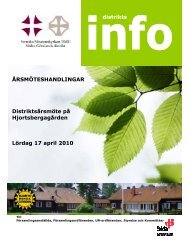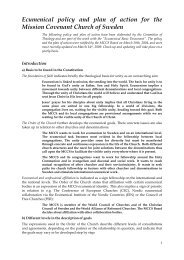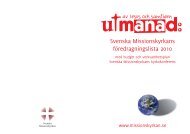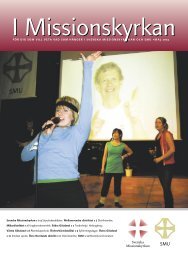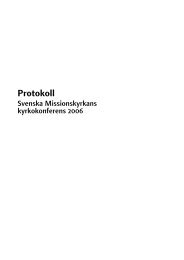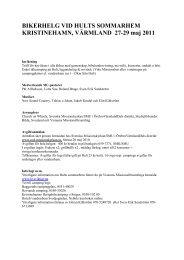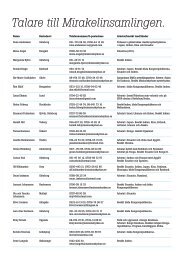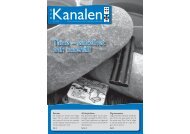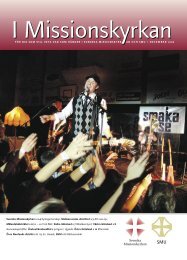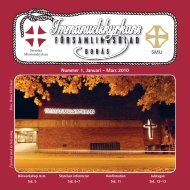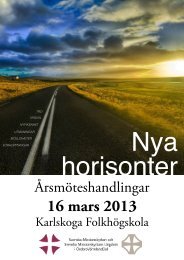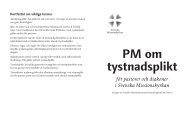Mission and Revolution in Central Asia - Svenska Missionskyrkan
Mission and Revolution in Central Asia - Svenska Missionskyrkan
Mission and Revolution in Central Asia - Svenska Missionskyrkan
You also want an ePaper? Increase the reach of your titles
YUMPU automatically turns print PDFs into web optimized ePapers that Google loves.
“The mosque itself is made up of an open court or rather a park. In front, there is the big water reservoir<br />
<strong>and</strong> the prayer-wheel with its pillars <strong>in</strong> an open row. Now the whole park is full of pray<strong>in</strong>g people <strong>in</strong><br />
perfectly arranged rows. The ground is covered with prayer-mats also arranged <strong>in</strong> rows as far as can be<br />
seen. People are ly<strong>in</strong>g on these mats, side by side as close together as possible. From the platform up <strong>in</strong><br />
front there are silent <strong>in</strong>structions, <strong>and</strong> now the ‘foam<strong>in</strong>g sea’ is heav<strong>in</strong>g up <strong>and</strong> down, like wave after<br />
wave, very regular <strong>and</strong> very dignified <strong>in</strong> a quiet way. There are no shouts of comm<strong>and</strong>, no conductor’s<br />
baton ... Immense is this crowd of tens of thous<strong>and</strong>s of the Kashgar Mohammedans.” 151<br />
M<strong>in</strong>arets were parts of the mosques <strong>in</strong> Eastern Turkestan. This was not very common <strong>in</strong><br />
Ch<strong>in</strong>a. Marshall Broomhall, a missionary form the Ch<strong>in</strong>a Inl<strong>and</strong> <strong>Mission</strong>, po<strong>in</strong>ts out that the<br />
Mosques <strong>in</strong> Ch<strong>in</strong>a did not differ appreciably from other temples, seen from the outside.<br />
Eastern Turkestan m<strong>in</strong>arets were an <strong>in</strong>fluence from Russian architecture accord<strong>in</strong>g to<br />
Broomhall. 152 He also mentions another particularity which dist<strong>in</strong>guished Ch<strong>in</strong>ese Muslims<br />
from the rest of the Muslim world. In <strong>Central</strong> Ch<strong>in</strong>a there were special women’s mosques<br />
which were not to be found <strong>in</strong> Eastern Turkestan, where women had to pray <strong>in</strong> their homes.<br />
The Koran covered all aspects of faith <strong>and</strong> life <strong>and</strong> was regarded as div<strong>in</strong>e. Kraemer po<strong>in</strong>ts<br />
out that the fundamental position of Islam is not “the Word was made flesh” but rather “The<br />
Word was made book”. 153 In the Koran there are many concepts borrowed both from Judaism<br />
<strong>and</strong> from Christianity. The Old Testament prophets for example are conta<strong>in</strong>ed <strong>in</strong> the Koran<br />
<strong>and</strong> Jesus is regarded as the last one of them. Jesus <strong>and</strong> the New Testament are however been<br />
passed by <strong>and</strong> the will of God is so much better <strong>and</strong> more completely expressed through<br />
Mohammed <strong>and</strong> the Koran. In Eastern Turkestan there was at the time of the <strong>Mission</strong> a bulky<br />
volume, the history of the Prophets, an addition to the Koran. It conta<strong>in</strong>ed h<strong>and</strong>written texts,<br />
translated from Persian, previously translated from Arabic. 154 It was however not allowed to<br />
translate the Koran itself. Its magnificence was partly due to the fact that it was written “<strong>in</strong><br />
the noblest of languages, classic Arabic.” 155<br />
The five Pillars of Islam <strong>and</strong> the religious obligations were observed more or less<br />
seriously. The profession of faith made a person a Muslim. “Muslim is any person who<br />
expresses the profession”. 156 The Muslims <strong>in</strong> Eastern Turkestan were fully conv<strong>in</strong>ced that the<br />
profession of faith gave them salvation <strong>and</strong> eternal life. One day a woman, who had recently<br />
become a widow, came to Raquette. She said that her husb<strong>and</strong> had been more ungodly than<br />
most people. But when he was about to die, he assured himself of eternal bliss by profess<strong>in</strong>g,<br />
“Allah is one, <strong>and</strong> apart from him there is no other god”. 157 Thus the profession of faith<br />
opened the door to the Muslim community dur<strong>in</strong>g ones lifetime <strong>and</strong> also gave the assurance<br />
of eternal life. Few s<strong>in</strong>s could change that state of facts. There were however th<strong>in</strong>gs that<br />
closed all possibilities of community <strong>and</strong> life, both <strong>in</strong> this life <strong>and</strong> <strong>in</strong> the life to come.<br />
Högberg relates such a case. Dur<strong>in</strong>g his time at the <strong>Mission</strong> station of Jengi-Hessar, he got to<br />
know a man who had taken a prostitute as his wife. Their two daughters followed their<br />
mother’s way of life. The man himself was a drunkard <strong>and</strong> he also led others <strong>in</strong>to his own<br />
dr<strong>in</strong>k<strong>in</strong>g habits. He was expelled from the Muslim community. And when he died, nobody<br />
cared for him. Long before his death he had arranged for a burial-site with<strong>in</strong> his own<br />
compound because he knew he could not expect to be buried <strong>in</strong> a Muslim burial-ground.<br />
151 Törnquist, 1926, p. 126 f.<br />
152 Broomhall, 1910, p. 237.<br />
153 Kraemr, 140, p. 233.<br />
154 Högberg-Ahlbert, 1925, p. 69 ff.<br />
155 Arbman, 1957, p. 82.<br />
156 Ericsson, 1967.<br />
157 The <strong>Mission</strong>sförbundet, 1905, p. 230.<br />
19



